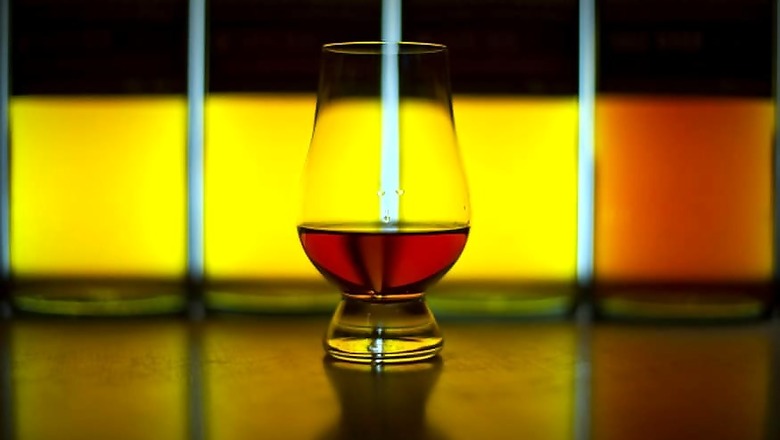
views
 Have you ever heard of Aston Martin One -77? No? It is the top line, the cherry-on-the-cream luxurious car. “Forget it sir, you won’t be able to buy it,” the salesman at the showroom brushes you away with a shrug amidst that blanket of politeness he pulls over his eyes.
Have you ever heard of Aston Martin One -77? No? It is the top line, the cherry-on-the-cream luxurious car. “Forget it sir, you won’t be able to buy it,” the salesman at the showroom brushes you away with a shrug amidst that blanket of politeness he pulls over his eyes.
Sorry, we are here for whisky.
Tell me. What are the Aston Martins in the world of whiskies? I mean, the top ones. What? Can’t hear you. Scotch whiskey? Part the answer. It is just like shooting me the reply, ‘a Mumbaikar’ to the question: who is the greatest batsman in the world. Be specific.
You know that the world of whisky is divided into many classes. You know the basics of whisky. Malted barley + water + yeast = W.
Now the process. You boil the mashed barley. Taking the heat and the cue, the alcohol in the fermented grain with its low boiling point evaporates from the mess, soars up, and billows out as steam into a nearby cold chamber where it condenses down as clear liquid – almost whisky.
No, not yet, don’t leap to it. You can’t drink it now.
This liquid is so concentrated and fiery and immature that it should be schooled down by putting it away in casks which are then stored in dark and dingy warehouses for a pretty long time. A minimum period of three years is necessary to make the famous Scotch whisky.
Now listen carefully. If a popular distillery collects the liquid from the cask after the minimum period of three years, bottle it and sell it as such, (of course after adding enough water to cut down the cask strength), the dedicated brand drinkers will be hugely disappointed. They will soon look out for some other whisky.
Why! Simple. It’s almost impossible to reproduce the taste of a particular distillation in the next batch, even if it is in the case of a whisky from the same distillery. So many factors influence the taste, including the sort of cask used, the space inside it, the particular position of that cask inside the warehouse etc etc.
So the taste of Johnny Walker changes with every bottle. Burning all his pockets to remain loyal to the brand, could a Johnny fan tolerate a taste that takes him for a swing every time?
The whisky world took this as a huge challenge. People behind put their brains and of course noses together. And came back in the 19th century composing the greatest symphony in the drink world: Blended whisky!
The idea was simple. They found that a particular whisky coming out from a cask is like a small strain of music emanating from an instrument (The problem was that its note and timbre changed with each batch of the distillation). But what if you blend it with a whisky of another age from another cask, and then with a third whisky and then with a fourth? Complicated, eh? But for whisky nosers, who know every note of individual whisky by its taste and smell, it is not impossible to compose a symphony of different taste notes, which can bizarrely be repeated.
It’s just like my daughter creating the colour, 'cyan’ by blending individual colours. She knows what she wants; she knows the technique to mix; and she creates cyan and leaves a helluva lot of its splotches on my study whenever I leave. The process of cyan making is pure magic to the eyes Single-Malts into the world of painting. I am stunned watching it take form from colours that do not carry a hint of it. Blending is, I learned, part art part science part voodoo. Only a few know it.
Using the same method, great nosers sit down and mix things with a drink that exists only in their mind. They have brought whiskies from distilleries across the land to create the new blend that matches the one in their fancy. A brand taste is soon created in the world of whisky: a taste that would not vacillate with every blending. Johnny Walker began to hit the same pleasure centre every time a bottle is opened in any corner of the world. Once they pull a hit with a particular symphony of whisky, they keep the recipe under lock and key. But sometimes big brands replace a component whisky (when it gets unavailable as that distillery shuts down) with a new one, subtly changing the taste.
They invite wrath. Rarely they garner applause.
Blended Whisky
You’ve drunk only this version of Scotch. I mean. Most of you. 90% of whisky coming from Scotland and the rest of the world belongs to the category. Johnny Walker, Grants, Chivas Regal, Teachers etc are some classic examples.
Here’s the good malt whisky married off to cheaper grain whiskies (not barley, but wheat or maize is used to make grain whisky) – a marriage beneath its station. The sharp tang of malt is trimmed down by the bland grain whisky, producing a sweeter, rounder appeal on the palate.
Blended whisky is like Hollywood films, popular, appealing to one and all. Whiskies from many distilleries across the terrain of Scotland (sometimes 20 to 50 whiskies are mixed to make a blended whiskey) are blended to create this wonder.
Single-Malts
Many consider them to be the Rolls Royce in the world of whiskies. There’s a popular misconception that Single Malt is SINGLE. No. It is also married, merrily to too many whiskies. The word ‘single’ refers to the distillery.
Unlike blended whiskies where the house whisky is married off to whiskies from other regions and distilleries, a ‘single malt’ inbreeds, marries its own cousins — the distillery’s own whiskeys of different ages.
Anything that inbreeds tends to reflect the character and terroir of the house style strongly. So is Single Malt. “Ah, the taste of Speyside!” You can wonder after taking one sip. Even if you haven’t understood why you just said it.
Single malt is award movie, esoteric, appealing only to a few who have grown into its small world. When you go higher up in the family of blended whiskies you can see products that are blends of only single malt whiskies, without much of the inferior grain whisky.
Single Cask whisky
I don’t know whether you have seen the superstar among the whiskies: the single cask ones. As the name suggests, it is taken from a single cask. It is bottled on special occasions with the knowledge that the unique taste can never be repeated.
So the whisky nosers spent almost ages to choose the right cask for bottling the essence of the special moment for which this mode of whisky is hand-chiselled.
As the promise goes when you get one you will let me know.
(Manu Remakant is a freelance writer who also runs a video blog — A Cup of Kavitha — introducing world poetry to Malayalees. Views expressed here are personal)
















Comments
0 comment